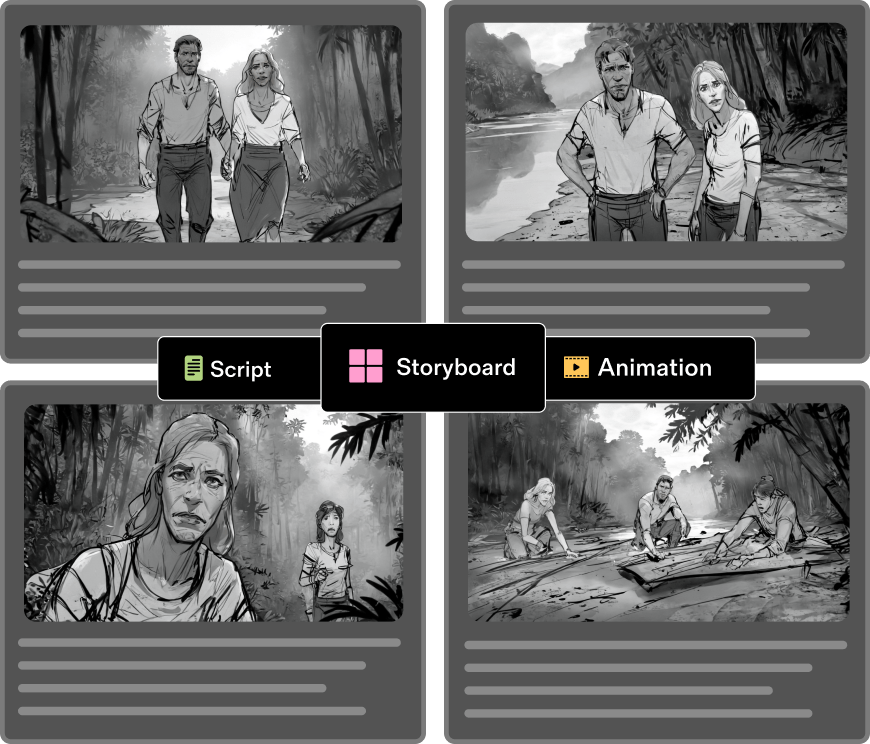A comics storyboard is a crucial tool in the comic creation process, serving as a preliminary visual outline that helps artists and writers plan and organize their narratives. By sketching out the sequence of panels, such as splash pages and gutters, creators can visualize the flow of the story, experiment with layout and composition, and ensure that characters and actions, like superhero poses or fight sequences, are consistent throughout.



This process not only aids in maintaining narrative coherence but also allows for effective pacing and dynamic visual storytelling. Using thumbnails and rough sketches, a storyboard facilitates collaboration and feedback, making it an indispensable step in bringing a comic book or graphic novel to life.

Comic book artists create storyboards to plan the visual flow and layout of each page, ensuring that the story is engaging and visually cohesive.

Writers and authors use storyboards to outline the narrative structure and key scenes, helping to visualize the story and communicate ideas to the artists.

Graphic novelists rely on storyboards to map out complex story arcs and character development, maintaining consistency and pacing across multiple chapters.

Storyboard artists specialize in creating detailed storyboards for various media, including comics, to convey the narrative and visual direction effectively.

Animators use comic storyboards to plan animated sequences, ensuring smooth transitions and clear visual storytelling.

Illustrators create storyboards to explore composition, perspective, and visual storytelling techniques before committing to final illustrations.
Early 20th Century
1930s
1940s-1950s
1960s
1970s-1980s
1990s
2000s-Present
Storyboarding remains a foundational element of the comic production process, continually evolving with technological advancements while maintaining its core purpose of visual storytelling.



.jpg)

Translating a written script into visual panels can be challenging. Comics storyboarding helps artists and writers visualize how scenes will unfold, facilitating a clearer understanding of the narrative flow and pacing of the story.

Ensuring that scenes have the correct timing and pacing is crucial in comics. Storyboards enable creators to map out the timing of each scene and adjust the pacing to maintain reader engagement and effectively convey the story.

Maintaining continuity and consistency in character actions, settings, and overall visual style can be difficult. Storyboards provide a visual reference that helps keep these elements consistent throughout the comic creation process.

Conveying complex visual ideas and actions to a team can be challenging. Comics storyboards serve as a common visual language that all team members can understand, facilitating better communication and collaboration.

Potential problems with the narrative, panel composition, or scene transitions can be hard to spot in the script stage. Storyboarding allows creators to identify and address these issues early in the production process, saving time and resources.

Determining the best way to frame panels and compose scenes can be a challenge. Storyboards allow artists to experiment with different compositions and framing techniques before committing to final illustrations.

Planning and allocating resources effectively is crucial in comic production. Storyboards help producers and directors visualize the scope of each scene, making it easier to allocate resources such as time, budget, and manpower efficiently.

Complex action sequences or intricate movements can be difficult to draw without a clear plan. Storyboards break down these sequences into manageable parts, providing a clear roadmap for artists to follow.

Getting approval from clients or stakeholders can be a lengthy process. Storyboards provide a visual representation of the comic, making it easier for clients and stakeholders to understand the vision and provide feedback before the final artwork begins.

Experimenting with different ideas and concepts can be risky and time-consuming. Storyboards allow creators to quickly sketch out and test various ideas, making it easier to explore creative options without investing significant time and resources.
By addressing these challenges, storyboarding streamlines the comic creation process enhances communication, ensures consistency, and ultimately contributes to the creation of a more polished and effective final product.
Get Started for Free

Get Started for Free







By following these steps, you can efficiently create detailed, professional storyboards that enhance your animation project, streamline your workflow, and foster creative collaboration.
Get Started for Free


Generate complete, professional-level scripts from a description or an idea. Say goodbye to writer’s block.

Import your scripts in various formats, including FDX, CSV, PDF, or DOCX. We’ve got you covered.

Automatically convert your scripts into detailed storyboards, saving time and ensuring accuracy.

Maintain continuity with automated tools that ensure consistent character designs and scene layouts.

Upload a single photo of a character, and Katalist will transform it into your main character with one click.

Collaborate in real-time with your team, sharing and editing storyboards seamlessly.

Control camera angles, shots, and poses to create a visual story that fits your ultimate vision.
Choose Katalist AI for your storyboarding needs and experience a new level of creativity, efficiency, and collaboration in your comics projects.
Get Started for Free